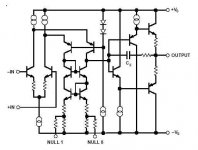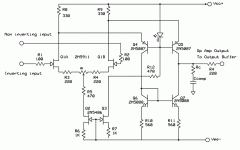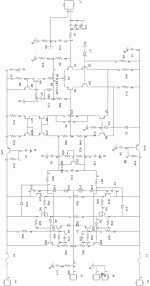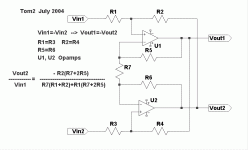Sorry, I am not quite get it. Is it folded cascode like this AD opamp offended the Master's SuSy patent? What are the other resemblence besides both using folded cascode? I tought the SuSy patent stressed on distortion canceling with 180deg output stages, not folded cascode.
Attachments
Hi, Mr. Pass,
The more I think, it scares me. You are a very gifted clever guy. You found most the best electronic cct principle first. They are the best. But is that anyone else cannot use them?
Is there any patents also for darlington, triple darlington, Vbe multiplier, CCS?
What can we make without them all?
The more I think, it scares me. You are a very gifted clever guy. You found most the best electronic cct principle first. They are the best. But is that anyone else cannot use them?
Is there any patents also for darlington, triple darlington, Vbe multiplier, CCS?
What can we make without them all?
Here is what I found at the Canadian Patent office web site where I have already worked a long time ago:
http://strategis.ic.gc.ca/sc_mrksv/cipo/patents/pat_gd_main-e.html
"...Patent infringement would occur if someone made, used or sold your patented door lock without your permission in a country that has granted you a patent, during the term of the patent.
If you believe your patent is infringed, you may sue for damages in the appropriate court. The defendant may argue that infringement did not occur, or may attack the validity of your patent. The court will determine who is right, basing its decision largely on the language of the claims. If what the defendant is doing is not within the wording of any of the claims of your patent, or if the patent is declared to be invalid for any reason, there is no infringement..."
"...A Canadian patent applies within Canada for 20 years from the date of filing of a patent application."
Fab
http://strategis.ic.gc.ca/sc_mrksv/cipo/patents/pat_gd_main-e.html
"...Patent infringement would occur if someone made, used or sold your patented door lock without your permission in a country that has granted you a patent, during the term of the patent.
If you believe your patent is infringed, you may sue for damages in the appropriate court. The defendant may argue that infringement did not occur, or may attack the validity of your patent. The court will determine who is right, basing its decision largely on the language of the claims. If what the defendant is doing is not within the wording of any of the claims of your patent, or if the patent is declared to be invalid for any reason, there is no infringement..."
"...A Canadian patent applies within Canada for 20 years from the date of filing of a patent application."
Fab
So Who can help me ,please?I don't have the forumula.
I simulate it with
npvfb.gif possible formula
Thanh how about this.
The general case is four equations, four unknowns.
I got it down to two equations, two unknowns and
then simplified them to the given special case.
The general case is a real mess to solve.
I checked it on paper for some cases and ran it on
spice and it seemed to be ok.
The equation can be played with to look better perhaps.
The SuSy equations are easier than this one.
Hopefully I'm right.
Hope it helps.
Tom
Thanh how about this.
The general case is four equations, four unknowns.
I got it down to two equations, two unknowns and
then simplified them to the given special case.
The general case is a real mess to solve.
I checked it on paper for some cases and ran it on
spice and it seemed to be ok.
The equation can be played with to look better perhaps.
The SuSy equations are easier than this one.
Hopefully I'm right.
Hope it helps.
Tom
Attachments
response to Thanh
Thanh,
I went back over deriving the formula and it appears correct.
Stability, I do not know.
I ran it on spice with the opamps modeled as a difference
junction connected to a gain block.
You could connect R2(R4) to ground then you would have the standard two opamp front end of a instrumentation amp. Although R1 and R2 (R3,R4) act as a voltage divider attenuating the input signal.
In fact let R2(R4) be open circuits(R2=R4=infinity) then the equation becomes the gain equation of the standard two opamp, three resistor topology. Math is so cool.
I have experimented around with some two opamp circuits.
Circuits like the SuSy are very pathological(unstable), others circuits can be stable or unstable depending on the voltage gains chosen.
Also input offset voltages and input bias currents can cause large dc offsets and even latch-up at the outputs due to all the loop gain.
Ultimately, you really need to build the circuit and play around with it.
Tom
Thanh,
I went back over deriving the formula and it appears correct.
Stability, I do not know.
I ran it on spice with the opamps modeled as a difference
junction connected to a gain block.
You could connect R2(R4) to ground then you would have the standard two opamp front end of a instrumentation amp. Although R1 and R2 (R3,R4) act as a voltage divider attenuating the input signal.
In fact let R2(R4) be open circuits(R2=R4=infinity) then the equation becomes the gain equation of the standard two opamp, three resistor topology. Math is so cool.
I have experimented around with some two opamp circuits.
Circuits like the SuSy are very pathological(unstable), others circuits can be stable or unstable depending on the voltage gains chosen.
Also input offset voltages and input bias currents can cause large dc offsets and even latch-up at the outputs due to all the loop gain.
Ultimately, you really need to build the circuit and play around with it.
Tom
- Status
- This old topic is closed. If you want to reopen this topic, contact a moderator using the "Report Post" button.
- Home
- Amplifiers
- Solid State
- Fully differential I/O amplifier



